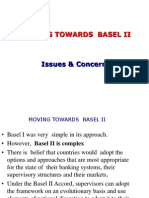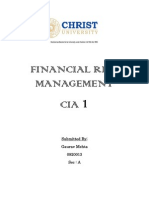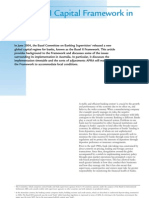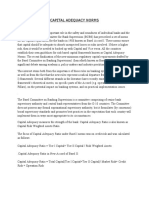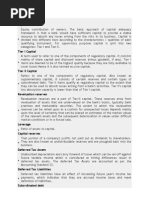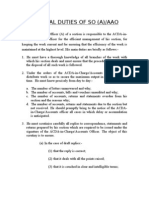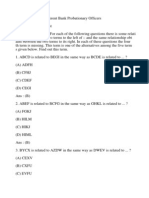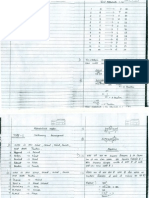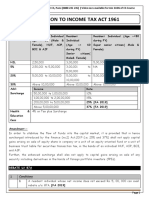Basel II Accord1
Basel II Accord1
Uploaded by
Alfaz AnsariCopyright:
Available Formats
Basel II Accord1
Basel II Accord1
Uploaded by
Alfaz AnsariCopyright
Available Formats
Share this document
Did you find this document useful?
Is this content inappropriate?
Copyright:
Available Formats
Basel II Accord1
Basel II Accord1
Uploaded by
Alfaz AnsariCopyright:
Available Formats
Basel II Accord Basel II Bank for International Settlements Basel Accord - Basel I Basel II Background Banking Monetary policy
- Central bank Risk - Risk management Regulatory capital Tier 1 - Tier 2 Pillar 1: Regulatory Capital Credit risk Standardized - F-IRB - A-IRB PD - LGD - EAD Operational risk Basic - Standardized - AMA Market risk Duration - Value at risk Pillar 2: Supervisory Review Economic capital Liquidity risk - Legal risk Pillar 3: Market Disclosure Disclosure Business and Economics Portal Basel II is the second of the Basel Accords, which are recommendations on banking laws and regulations issued by the Basel Committee on Banking Supervision. The purpose of Basel II, which was initially published in June 2004, is to create an international standard that banking regulators can use when creating regulations about how much capital banks need to put aside to guard against the types of financial and operational risks banks face.
Advocates of Basel II believe that such an international standard can help protect the international financial system from the types of problems that might arise should a major bank or a series of banks collapse. In practice, Basel II attempts to accomplish this by setting up rigorous risk and capital management requirements designed to ensure that a bank holds capital reserves appropriate to the risk the bank exposes itself to through its lending and investment practices. These rules mean that the greater risk to which the bank is exposed, the greater the amount of capital the bank needs to hold to safeguard its solvency and overall economic stability. The final version aims 1. Ensuring that capital allocation is more risk sensitive; 2. Separating operational risk from credit risk, and quantifying both; 3. Attempting to align economic and regulatory capital more closely to reduce the scope for regulatory arbitrage. While the final accord has largely addressed the regulatory arbitrage issue, there are still areas where regulatory capital requirements will diverge from the economic. Basel II has largely left unchanged the question of how to actually define bank capital, which diverges from accounting equity in important respects. The Basel I definition, as modified up to the present, remains in place. The Accord in operation Basel II uses a "three pillars" concept (1) minimum capital requirements (addressing risk), (2) supervisory review and (3) market discipline to promote greater stability in the financial system. The Basel I accord dealt with only parts of each of these pillars. For example: with respect to the first Basel II pillar, only one risk, credit risk, was dealt with in a simple manner while market risk was an afterthought; operational risk was not dealt with at all. The first pillar The first pillar deals with maintenance of regulatory capital calculated for three major components of risk that a bank faces: credit risk, operational risk and market risk. Other risks are not considered fully quantifiable at this stage. The credit risk component can be calculated in three different ways of varying degree of sophistication, namely standardized approach, Foundation IRB and Advanced IRB. IRB stands for "Internal Rating-Based Approach". For operational risk, there are three different approaches - basic indicator approach or BIA, standardized approach or TSA, and advanced measurement approach or AMA.
For market risk the preferred approach is VaR (value at risk). The second pillarThe second pillar deals with the regulatory response to the first pillar, giving regulators much improved 'tools' over those available to them under Basel I. It also provides a framework for dealing with all the other risks a bank may face, such as systemic risk, pension risk, concentration risk, strategic risk, reputation risk, liquidity risk and legal risk, which the accord combines under the title of residual risk. It gives bank a power to review their risk management system. The third pillarThe third pillar greatly increases the disclosures that the bank must make. This is designed to allow the market to have a better picture of the overall risk position of the bank and to allow the counterparties of the bank to price and deal appropriately. Basel II and the regulators One of the most difficult aspects of implementing an international agreement is the need to accommodate differing cultures, varying structural models and the complexities of public policy and existing regulation. Banks senior management will determine corporate strategy, as well as the country in which to base a particular type of business, based in part on how Basel II is ultimately interpreted by various countries' legislatures and regulators. To assist banks operating with multiple reporting requirements for different regulators according to geographic location, there are several software applications available. These include capital calculation engines and extend to automated reporting solutions which include the reports required under COREP/FINREP. Basel II norms: Strength from three pillars PILLAR I of Basel II norms provide banks with guidelines to measure the various types of risks they face credit, market and operational risks and the capital required to cover these risks. Credit risk A bank always faces the risk that some of its borrowers may renege on their promises for timely repayments of loan, interest on loan or meet the other terms of contract. This risk is called credit risk, which varies from borrower to borrower depending on their credit quality. Basel II requires banks to accurately measure credit risk to hold sufficient capital to cover it. Factors affecting credit risk can be summarised by the following formula:
Expected Loss (EL) on a loan = Exposure at default (EAD) * Loss given default (LGD) * Probability of Default (PD) The bank can also suffer losses in excess of expected losses, say, during economic downturns. These losses are called unexpected losses. Ideally, a bank should recover expected loss on a loan from its customer through loan pricing. The capital base is required to absorb the unexpected losses, as and when they arise. Market risk As part of the statutory requirement, in the form of SLR (statutory liquidity ratio), banks are required to invest in liquid assets such as cash, gold, government and other approved securities. For instance, Indian banks are required to invest 25 per cent of their net demand and term liabilities in cash, gold, government securities and other eligible securities to comply with SLR requirements. Such investments are risky because of the change in their prices. This volatility in the value of a bank's investment portfolio in known as the market risk, as it is driven by the market. The change in the value of the portfolio can be due to changes in the interest rates, foreign exchange rates or the changes in the values of equity or commodities. Operational risk Several events that are neither due to default by third party nor because of the vagaries of the market. These events are called operational risks and can be attributed to internal systems, processes, people and external factors. Pillar I ensures that banks measure their risks properly and maintain adequate capital to cover them. But can Pillar I alone ensure that there are no more bank failures? No. As any stable structure cannot stand on a single pillar, Basel II relies on the pillars of supervisory reviews and market discipline to keep the banks healthy. Pillar II ensures that not only do the banks have adequate capital to cover their risks, but also that they employ better risk management practices so as to minimise the risks. Capital cannot be regarded as a substitute for inadequate risk management practices. This pillar requires that if the banks use asset securitisation and credit derivatives and wish to minimise their capital charge they need to comply with various standards and controls. As a part of the supervisory process, the supervisors need to ensure that the regulations are adhered to and the internal measurement systems are standardised and validated. The supervisory process is based on four principles: Principle 1: Banks should have a process for assessing their overall capital adequacy
vis-a-vis their risk profile and a strategy for maintaining their capital levels. Principle 2: Supervisors should review and evaluate banks' internal capital adequacy assessments and strategies, as well as their ability to monitor and ensure compliance with regulatory capital ratios. Supervisors should take appropriate supervisory action if they are not satisfied with the result of this process. Principle 3: Supervisors should expect banks to operate above the minimum regulatory capital ratios and should have the ability to require banks to hold capital in excess of the minimum. Principle 4: Supervisors should seek to intervene at an early stage to prevent capital from falling below the minimum levels required to support the risk characteristics of a particular bank and should require rapid remedial action if capital is not maintained or restored. Given the kind of responsibilities, the supervisor's role assumes high importance in the new Basel II accord. Pillar II does not seek to harmonise supervisory processes across countries as they have different supervisory objectives, legal processes and authority of supervisors. It allows for sufficient national discretion but still it wants supervisors to maintain some degree of consistency in their approaches. Market discipline Banking operations are becoming complex and difficult for supervisors to monitor and control. Though supervisors try to inculcate corporate governance in banks, they can take cue from the market to buttress their supervisory and monitoring activities. In this context, Basel Committee has recognised that market discipline is so important that it warrants being the third pillar of Basel II norms. This market discipline is brought through greater transparency by asking banks to make adequate disclosures. The potential audiences of these disclosures are supervisors, bank's customers, rating agencies, depositors and investors. With frequent and material disclosures, outsiders can learn about the bank's risk. Armed with this information, the outsiders can always protect themselves by ending their relationships with the bank. Market discipline has two important components: Market signalling in form of change in bank's share prices or change in bank's borrowing rates Responsiveness of the bank or the supervisor to market signals
Seeing the importance of the impact that the markets can have on banks, Pillar III provides a comprehensive menu of public and regulatory disclosures like disclosures related to capital structure (core and supplementary capital), capital adequacy, risk assessment and risk management processes to enhance the transparency in banking operations. What they mean for banks BASEL II norms are expected to have far-reaching consequences on the health of financial sectors worldwide because of the increased emphasis on banks' riskmanagement systems, supervisory review process and market discipline. The new norms bring to fore not only the issues of bank-wide risk measurement but also of active risk management. This will help in better pricing of the loans in alignment with their actual risks. The beneficiary will be the customer with high credit-worthiness and ratings as they will be able to get cheaper loans. Basel II norms require vast amount of historical data and advanced techniques and software for calculation of risk measures. This will translate into huge demand for IT, BPO and outsourcing services. According to estimates, cost of implementation of the new norms may range from $10 million to $150 million depending on the size of the bank. A flip side is that the knowledge acquired by the big banks due to the implementation of complex norms would act as an entry barrier to any new competition entering into the market, as international markets provide incentive to sovereigns and banks that have implemented Basel II. Small and medium sized banks will find it difficult to finance high implementation costs of the norms. If national supervisors make the norms compulsory to implement, these banks might have no other option but to merge with other banks. Therefore, consolidation in banking industry with increased mergers and acquisitions is expected. Higher risk sensitivity of the norms provides no incentive to lend to borrowers with declining credit quality. During economic downturns, corporate profits and ratings tend to decline. This can lead to banks pulling the plugs on lending to corporates with falling credit ratings, at a time when these companies will be in desperate need of credit. The opposite is expected during economic booms, when corporate credit worthiness improves and banks will be more than willing to lend to corporates. With better risk measurement practices in place the capital allocation for loans to quality borrowers are going to decrease. Banks can use this capital for other purposes to
increase profits. But the population of rated corporate is small in India and most of them would have to be assigned a risk weight of 100 per cent. The benefit of lower risk weight of 20 per cent and 50 per cent would, therefore, be available only for loans to a few corporates. The cover required for bad loans will increase exponentially with deteriorating credit quality, which can lead to an increase in capital requirement.
You might also like
- The Following Is The Unadjusted Trial Balance For Rocky MountainDocument2 pagesThe Following Is The Unadjusted Trial Balance For Rocky MountainMiroslav GegoskiNo ratings yet
- Basel NormsDocument23 pagesBasel NormsPranu PranuNo ratings yet
- HDFC Bank Camels AnalysisDocument15 pagesHDFC Bank Camels AnalysisfkkfoxNo ratings yet
- Basel IIDocument4 pagesBasel IIbaljeet1992No ratings yet
- Salient Features of BaselDocument3 pagesSalient Features of BaselMrinmayi NaikNo ratings yet
- Basel IIDocument3 pagesBasel IIpooja_shah7905010No ratings yet
- Riit Assignment: Basel-Ii and Risk ManagenentDocument13 pagesRiit Assignment: Basel-Ii and Risk ManagenentAddy ColumbusNo ratings yet
- Non Performing Asset (NpaDocument17 pagesNon Performing Asset (NpaVivek GoelNo ratings yet
- Basel 2 NormsDocument21 pagesBasel 2 NormsamolreddiwarNo ratings yet
- Basel II: Jump ToDocument12 pagesBasel II: Jump ToKeshav SardaNo ratings yet
- Basel II AccordDocument5 pagesBasel II Accordmhossain98No ratings yet
- Basel Accord IIDocument13 pagesBasel Accord IIAdnan HadziibrahimovicNo ratings yet
- Basel II: Basel Accords Basel Committee On Banking SupervisionDocument10 pagesBasel II: Basel Accords Basel Committee On Banking SupervisiondebasishpahiNo ratings yet
- Basel II - A Risk Management TechniqueDocument5 pagesBasel II - A Risk Management TechniqueAli KhojaNo ratings yet
- Moving Towards Basel Ii: Issues & ConcernsDocument36 pagesMoving Towards Basel Ii: Issues & Concernstejasdhanu786No ratings yet
- Report 19 PDFDocument52 pagesReport 19 PDFAnshuman DasNo ratings yet
- Neha Gundherva 09bsddu0083Document10 pagesNeha Gundherva 09bsddu0083Neha GundhervaNo ratings yet
- Basel I II IIIDocument20 pagesBasel I II IIISachin TodurNo ratings yet
- Basel IIDocument5 pagesBasel IIcozycapNo ratings yet
- Basel IIDocument3 pagesBasel IIAsif MirzaNo ratings yet
- Bank Basel Capital Accords by YTNDocument19 pagesBank Basel Capital Accords by YTNYisehakNo ratings yet
- 10 Capital Adequacy NormsDocument23 pages10 Capital Adequacy NormsBindal HeenaNo ratings yet
- UNIT IV Banking Theory Law and PracticeDocument8 pagesUNIT IV Banking Theory Law and PracticeLoganathan KrishnasamyNo ratings yet
- Basel NormsDocument19 pagesBasel NormsJoelNo ratings yet
- Banking Regulatory Environment: Basel GuidelinesDocument7 pagesBanking Regulatory Environment: Basel GuidelinesNidhi Modi KariaNo ratings yet
- Objective: Basel II Is The Second of TheDocument5 pagesObjective: Basel II Is The Second of Theaquarianmansi2212No ratings yet
- FRM Cia 1Document10 pagesFRM Cia 1Gaurav MehtaNo ratings yet
- Commercial Banking NotesDocument5 pagesCommercial Banking NotesabhijeetmohanNo ratings yet
- BASEL1Document7 pagesBASEL1Ritu SharmaNo ratings yet
- Base 2Document20 pagesBase 2asifanisNo ratings yet
- BASEL Norms of IndiaDocument18 pagesBASEL Norms of IndiaMeghanaNo ratings yet
- Basel 2 NormsDocument11 pagesBasel 2 NormsAbhishek RajputNo ratings yet
- Assignment On BASELDocument4 pagesAssignment On BASELMahiTrisha100% (1)
- 1530266570ECO P11 M28 E-TextDocument12 pages1530266570ECO P11 M28 E-TextMonika SainiNo ratings yet
- The Significance of Basel 1 and Basel 2 For The Future of The Banking Industry With Special Emphasis On Credit InformationDocument21 pagesThe Significance of Basel 1 and Basel 2 For The Future of The Banking Industry With Special Emphasis On Credit InformationSohaib ButtNo ratings yet
- Basel II PresentationDocument21 pagesBasel II PresentationMuhammad SaqibNo ratings yet
- Interpreting The IRB Capital Requirements in Basel IIDocument34 pagesInterpreting The IRB Capital Requirements in Basel IIcriscincaNo ratings yet
- Basel 3Document3 pagesBasel 3NITIN PATHAKNo ratings yet
- Risk Management in Banks and Basel - II ComplianceDocument35 pagesRisk Management in Banks and Basel - II ComplianceSrinivas AcharNo ratings yet
- Basel 123Document4 pagesBasel 123RiazRahmanNo ratings yet
- Interpreting The IRB Capital Requirements in Basel IIDocument31 pagesInterpreting The IRB Capital Requirements in Basel IIcriscinca100% (1)
- Risk Management Framework: by Prof Santosh KumarDocument30 pagesRisk Management Framework: by Prof Santosh KumarAYUSH RAVINo ratings yet
- Financial Chapter 6Document7 pagesFinancial Chapter 6yihun0521No ratings yet
- College ProjectDocument72 pagesCollege Projectcha7738713649No ratings yet
- Basel Norms I, II and IIIDocument30 pagesBasel Norms I, II and IIIYashwanth PrasadNo ratings yet
- APRA Bassel 11 Paper March 2005Document6 pagesAPRA Bassel 11 Paper March 2005Leanne DongNo ratings yet
- HDFC Bank CAMELS AnalysisDocument15 pagesHDFC Bank CAMELS Analysisprasanthgeni22No ratings yet
- Adoption of Basel II NormsDocument5 pagesAdoption of Basel II NormsDivya GoelNo ratings yet
- Literature Review Basel IIDocument6 pagesLiterature Review Basel IIc5pjg3xh100% (1)
- Capital Adequacy NormsDocument13 pagesCapital Adequacy NormsicdawarNo ratings yet
- BASEL II Concept & ImplicationDocument17 pagesBASEL II Concept & Implicationfar_07No ratings yet
- Capital Capital FundsDocument12 pagesCapital Capital FundsDrKhalid A ChishtyNo ratings yet
- Nalysis Of: Third Time's The CharmDocument47 pagesNalysis Of: Third Time's The CharmUmair ChishtiNo ratings yet
- Capital Capital FundsDocument11 pagesCapital Capital FundsSantosh Kumar BarikNo ratings yet
- BASEL Norms Concept & Implication: Awadhesh Kumar Patel & Manish Kumar SoniDocument17 pagesBASEL Norms Concept & Implication: Awadhesh Kumar Patel & Manish Kumar SoniAnjalinishantNo ratings yet
- Basel II: Implications For Islamic BankingDocument27 pagesBasel II: Implications For Islamic BankingroytanladiasanNo ratings yet
- Glossary PDFDocument8 pagesGlossary PDFkumarsanjeev.net9511No ratings yet
- The Basel II Risk Parameters: Estimation, Validation, Stress Testing - with Applications to Loan Risk ManagementFrom EverandThe Basel II Risk Parameters: Estimation, Validation, Stress Testing - with Applications to Loan Risk ManagementRating: 1 out of 5 stars1/5 (1)
- The Basel Ii "Use Test" - a Retail Credit Approach: Developing and Implementing Effective Retail Credit Risk Strategies Using Basel IiFrom EverandThe Basel Ii "Use Test" - a Retail Credit Approach: Developing and Implementing Effective Retail Credit Risk Strategies Using Basel IiNo ratings yet
- I DB I Exam 2005 Quantitative Aptitude PaperDocument5 pagesI DB I Exam 2005 Quantitative Aptitude PaperPrabha ForuallNo ratings yet
- Bank PaperDocument78 pagesBank Paperdewangan_tNo ratings yet
- 2010 12 14 - Page8Document1 page2010 12 14 - Page8Alfaz AnsariNo ratings yet
- 2010 12 14 - Page8Document1 page2010 12 14 - Page8Alfaz AnsariNo ratings yet
- Tricks To Solve Time and Distance ProblemsDocument36 pagesTricks To Solve Time and Distance ProblemsvidhyaadhiyamanNo ratings yet
- Profiles of Govt JobsDocument5 pagesProfiles of Govt JobsAlfaz AnsariNo ratings yet
- National IncomeDocument8 pagesNational IncomeDeepak Tyagi100% (11)
- Model Paper For Different Bank Probationary Officers Reasoning Ability TestDocument75 pagesModel Paper For Different Bank Probationary Officers Reasoning Ability TesttyagrajNo ratings yet
- Prasad's Quicker Math-Vol 1Document178 pagesPrasad's Quicker Math-Vol 1Sudhir ShanklaNo ratings yet
- What Is A Foreign Currency Convertible Bond (FCCB) ? A ForeignDocument9 pagesWhat Is A Foreign Currency Convertible Bond (FCCB) ? A ForeignParas R AsharaNo ratings yet
- Prasad's Quicker Math-Vol 1Document178 pagesPrasad's Quicker Math-Vol 1Sudhir ShanklaNo ratings yet
- NCFM Module - 1 Financial Markets: A Beginner's Module by Wahid311Document93 pagesNCFM Module - 1 Financial Markets: A Beginner's Module by Wahid311Abdul Wahid KhanNo ratings yet
- How To Solve INPUT-OUTPUT Question of Bank PODocument48 pagesHow To Solve INPUT-OUTPUT Question of Bank POvaibhavkushwah100% (1)
- MathsDocument22 pagesMathsAlfaz AnsariNo ratings yet
- BarodaDocument10 pagesBarodaAlfaz AnsariNo ratings yet
- Govt. Programme and PoliciesDocument5 pagesGovt. Programme and PoliciesAlfaz AnsariNo ratings yet
- Cash - CRDocument14 pagesCash - CRpingu patwhoNo ratings yet
- Long Examination Cash Set ADocument3 pagesLong Examination Cash Set AprechuteNo ratings yet
- Sunway Tes Financial Accounting ACCA Chapter AssessmentDocument228 pagesSunway Tes Financial Accounting ACCA Chapter AssessmentFarahAin FainNo ratings yet
- Pas 41 AgricultureDocument5 pagesPas 41 Agriculturetrevor.v.philips23No ratings yet
- Problems On General Insurance Companies AccountsDocument4 pagesProblems On General Insurance Companies Accountsgowrirao496No ratings yet
- Grade 11 Math MOd 6Document12 pagesGrade 11 Math MOd 6John Lois VanNo ratings yet
- Statement XXXX XXXX 8218 16mar2024!11!51Document10 pagesStatement XXXX XXXX 8218 16mar2024!11!51daimimahesan65No ratings yet
- Investment in AssociateDocument20 pagesInvestment in AssociateMaricon BerjaNo ratings yet
- GFS 2001 Manual-Basic ConceptsDocument40 pagesGFS 2001 Manual-Basic ConceptsProfessor Tarun DasNo ratings yet
- CS Executive Tax Laws Amendments by Vipul ShahDocument41 pagesCS Executive Tax Laws Amendments by Vipul ShahCloxan India Pvt LtdNo ratings yet
- CO1 2201E IP03.SolutionDocument1 pageCO1 2201E IP03.SolutionElaNo ratings yet
- ProjectDocument80 pagesProjectharjot singhNo ratings yet
- Role of Banks in Indian EconomyDocument2 pagesRole of Banks in Indian EconomyPriyanka MuppuriNo ratings yet
- CH 21Document144 pagesCH 21fiorensaNo ratings yet
- Practice ProblemsDocument6 pagesPractice ProblemsAvox EverdeenNo ratings yet
- Credit RatingDocument63 pagesCredit Ratingnikhu_shukla100% (1)
- Questionnaire For SMEDocument2 pagesQuestionnaire For SMELeo John0% (1)
- IMAA Valuation Program BrochureDocument12 pagesIMAA Valuation Program Brochurehjain5964No ratings yet
- Problems On Income From House Property - 2023 2024Document3 pagesProblems On Income From House Property - 2023 2024goli pandeyNo ratings yet
- Acco 1000 4.1Document12 pagesAcco 1000 4.1Carmen Miliza Ortiz de OcañaNo ratings yet
- Summer Internship Project Company: Edelweiss Stock Broking Ltd. Proect Title: An Analysis of Investment Avenues Prevailing in IndiaDocument11 pagesSummer Internship Project Company: Edelweiss Stock Broking Ltd. Proect Title: An Analysis of Investment Avenues Prevailing in IndiaDEBALINA SENNo ratings yet
- FinClub - 57th Batch Interview Question BankDocument16 pagesFinClub - 57th Batch Interview Question BankAKSHAY PANWARNo ratings yet
- Reserve Bank of India भारतीय रिरज़र्व बैंकDocument14 pagesReserve Bank of India भारतीय रिरज़र्व बैंकRahul MittalNo ratings yet
- Solution: Money, Banking, and The Federal Reserve SystemDocument10 pagesSolution: Money, Banking, and The Federal Reserve SystemrashiNo ratings yet
- List of Quoted Companies in Nigeria Company Name 0 - 9 A - DDocument6 pagesList of Quoted Companies in Nigeria Company Name 0 - 9 A - DAdetokunbo AdemolaNo ratings yet
- Print Reciept RequestDocument1 pagePrint Reciept RequestAdewoye WasiuNo ratings yet
- Case 5-1Document4 pagesCase 5-1fitriNo ratings yet
- Fee ScheduleDocument5 pagesFee Schedulewing tamNo ratings yet
- Indian Financial System by Darshan Toprani Series 1Document14 pagesIndian Financial System by Darshan Toprani Series 1nareshchinna1No ratings yet














